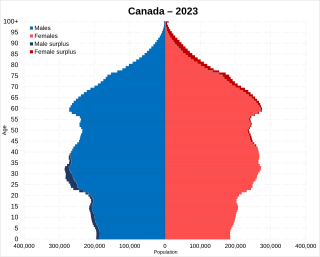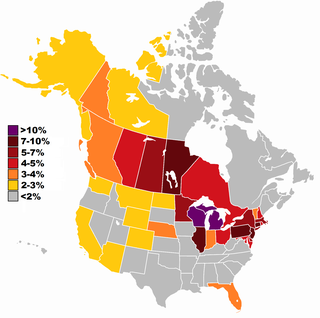
Statistics Canada conducts a country-wide census that collects demographic data every five years on the first and sixth year of each decade. The 2021 Canadian census enumerated a total population of 36,991,981, an increase of around 5.2 percent over the 2016 figure, Between 2011 and May 2016, Canada's population grew by 1.7 million people, with immigrants accounting for two-thirds of the increase. Between 1990 and 2008, the population increased by 5.6 million, equivalent to 20.4 percent overall growth. The main driver of population growth is immigration, and to a lesser extent, natural growth.

According to the 2021 Canadian census, over 450 "ethnic or cultural origins" were self-reported by Canadians. The major panethnic origin groups in Canada are: European (52.5%), North American (22.9%), Asian (19.3%), North American Indigenous (6.1%), African (3.8%), Latin, Central and South American (2.5%), Caribbean (2.1%), Oceanian (0.3%), and Other (6%). Statistics Canada reports that 35.5% of the population reported multiple ethnic origins, thus the overall total is greater than 100%.

Polish Canadians are citizens of Canada with Polish ancestry, and Poles who immigrated to Canada from abroad. At the 2016 Census, there were 1,106,585 Canadians who claimed full or partial Polish heritage.

Dutch Canadians are Canadians with full or partial Dutch ancestry. According to the Canada 2006 Census, there were 1,035,965 Canadians of Dutch descent, including those of full or partial ancestry. This increased to 1,111,655 in 2016.
Swedish Canadians are Canadian citizens of Swedish ancestry or Swedes who emigrated to and reside in Canada. The Swedish Canadian community in Canada numbered 349,640 in the 2016 population census. The vast majority of them reside west of Lake Superior, primarily in Winnipeg, Calgary, Edmonton and Vancouver. Toronto is the most popular settlement spot for newcomers. Despite having an influential presence and distinctive cultural bond, only 14,000 Canadian persons of Swedish descent speak Swedish.
Finnish Canadians are Canadian citizens of Finnish ancestry or Finns who emigrated to and reside in Canada. In 2016, 143,645 Canadians claimed Finnish ancestry. Finns started coming to Canada in the early 1880s, and in much larger numbers in the early 20th century and well into the mid-20th century. Finnish immigration to Canada was often a direct result of economic depressions and wars, or in the aftermath of major conflicts like the Finnish Civil War. Canada was often chosen as a final destination because of the similarity in climate and natural conditions, while employment in logging or homesteading attracted landless farmers in the early 20th century. Migratory movements of Finns between Canada and the United States was very common as well.
Icelandic Canadians are Canadian citizens of Icelandic ancestry, or Iceland-born people who reside in Canada.
The demographics of Toronto, Ontario, Canada make Toronto one of the most multicultural and multiracial cities in the world. In 2021, 57.0 percent of the residents of the metropolitan area belonged to a visible minority group, compared with 51.4 percent in 2016, and 13.6 percent in 1981. Toronto also has established ethnic neighbourhoods such as the multiple Chinatowns, Corso Italia, Little Italy, Little India, Greektown, Koreatown, Little Tokyo, Little Jamaica, Little Portugal, Little Malta, Roncesvalles (Polish), Bloor West Village (Ukrainian), which celebrate the city's multiculturalism. Data from the suburban municipalities are also included for some metrics as most of these municipalities are part of the Toronto CMA.
Danish Canadians are Canadian citizens of Danish ancestry. According to the 2006 Census, there were 200,035 Canadians with Danish background, 17,650 of whom were born in Denmark.
The demographics of Metro Vancouver indicate a multicultural and multiracial region. Metro Vancouver is a metropolitan area, with its major urban centre being Vancouver, British Columbia, Canada. The Vancouver census metropolitan area, as defined by Statistics Canada, encompasses roughly the same territory as the Metro Vancouver Regional District, a regional district in British Columbia. The regional district includes 23 local authorities. Figures provided here are for the Vancouver census metropolitan area and not for the City of Vancouver.

British Columbia is a Canadian province with a population of about 5.5 million people. The province represents about 13.2% of the population of the Canadian population. Most of the population is between the ages of 15 and 49. About 60 percent of British Columbians have European descent with significant Asian and Aboriginal minorities and just under 30% of British Columbians are immigrants. Over half of the population is irreligious, with Christianity and Sikhism being the most followed religions.

Ontario, one of the 13 provinces and territories of Canada, is located in east-central Canada. It is Canada's most populous province by a large margin, accounting for nearly 40 per cent of all Canadians, and is the second-largest province in total area. Ontario is fourth-largest in total area when the territories of the Northwest Territories and Nunavut are included. It is home to the nation's capital city, Ottawa, and the nation's most populous city, Toronto.
Norwegian Canadians refer to Canadian citizens who identify themselves as being of full or partial Norwegian ancestry, or people who emigrated from Norway and reside in Canada.

The community of Serbian Canadians includes Canadian citizens of Serb ethnicity, or people born in Serbia who permanently reside in Canada. Serbs have migrated to Canada in various waves during the 20th century. Today there are five or more generations of Serbs in the country. The 2021 census recorded 93,360 people in Canada declaring themselves as "Serbian". Serbian Canadians generally belong to the Serbian Orthodox Church and follow the Eastern Orthodox tradition.

Alberta has experienced a relatively high rate of growth in recent years, due in large part to its economy. Between 2003 and 2004, the province saw high birthrates, relatively high immigration, and a high rate of interprovincial migration when compared to other provinces. Approximately 81% of the population live in urban areas and only about 19% live in rural areas. The Calgary–Edmonton Corridor is the most urbanized area in Alberta and is one of Canada's four most urban regions. Many of Alberta's cities and towns have also experienced high rates of growth in recent history. From a population of 73,022 in 1901, Alberta has grown to 3,645,257 in 2011 and in the process has gone from less than 1.5% of Canada's population to 10.9%. As of July 1, 2018, Alberta's population represented 11.6% of Canada's total population of 37,058,856 making it the fourth most populated province in Canada. According to the 2018 third quarter report, Alberta's population increased by 23,096 to 4,330,206, the largest increase since the 2014 economic downturn.
European Canadians, or Euro-Canadians, are Canadians who were either born in or can trace their ancestry to the continent of Europe. They form the largest panethnic group within Canada.
Pakistani Canadian refers to the community in Canada of Pakistani heritage or descent. It can also refer to people who hold dual Pakistani and Canadian citizenship. Categorically, Pakistani Canadians comprise a subgroup of South Asian Canadians which is a further subgroup of Asian Canadians.
Belgian Canadians are Canadian citizens of Belgian ancestry or Belgium-born people who reside in Canada. According to the 2011 census there were 176,615 Canadians who claimed full or partial Belgian ancestry. It encompasses immigrants from both French and Dutch-speaking parts of Belgium.
The demographics of Winnipeg reveal the city to be a typically Canadian one: multicultural and multilingual. Winnipeg is also prominent in the size and ratio of its First Nations population, which plays an important part in the city's makeup. About 12.4% of Winnipeggers are of Indigenous descent, which vastly exceeds the national average of 5.0%.
Austrian Canadians are Canadian citizens who are of Austrian ancestry or Austrian-born people who reside in Canada. According to the 2021 Census, there were 189,535 Canadians who claimed either full or partial Austrian ancestry.







